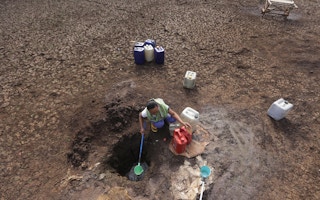Dozens of families used to live in this once-vibrant village in eastern Nepal, but Sarita Rai can now count the number of households that remain on one hand.
The exodus has been driven by a lack of water, as rainfall falters and springs and streams dry up, the 52-year-old said - and most of those with the means to leave have already gone.
“There were about 63 households when I came here after getting married (about 27 years ago), but now there are only five households remaining,” she said from Purana Gaun, in Nepal’s hilly Khotang district.
Around the world, climate change and nature losses are fuelling harsher and more frequent droughts and shifts in rainfall patterns, with ever-scarcer water expected to become an increasingly major driver of migration.
Until recently, Rai had to wake up at 3 a.m. daily to fetch water for her family, with the volume from a nearby spring-fed tap having fallen so precipitously it often took her an hour to collect just seven litres.
Then last month, the pipe connecting the tap to the spring was destroyed by a wildfire, disrupting the supply. Now Rai has to walk two hours each way to get water from a river downhill.
Facing such burdens, Rai hopes she will soon be able to join the exodus.
“Those who had enough money to build houses have migrated to get access to water - but we don’t have enough money,” she said.
“
Once people have moved out of a place where they have stayed for generations, they rarely move back even if the problem of the water crisis is solved.
Amina Maharjan, livelihood specialist, International Centre for Integrated Mountain Development
Her two sons have already migrated to Malaysia to find work, she said, emphasising that she hoped to move elsewhere in Nepal once her children had saved enough to help her do so.
Nepal is the fourth most climate-vulnerable country in the world, according to World Bank rankings, and increasingly extreme weather fuelled by climate change is bringing worsening water extremes, from droughts to floods that wash away homes and even entire villages.
Water shortages are a problem nationwide, but they are most acute in hilly areas, including those near the Hindu-Kush and Himalayan mountains, where drying springs and erratic rain and snowfall are causing a water crisis, said Roshan Babu Ojha, a soil scientist at the National Soil Science Research Center.
For some villages, water is not just running short but running out, forcing migration, according to local people, officials and migration specialists.
That threatens the fabric and future of many communities, said Amina Maharjan of the International Centre for Integrated Mountain Development (ICIMOD).
“Once people have moved out of a place where they have stayed for generations, they rarely move back even if the problem of the water crisis is solved,” said Maharjan, senior specialist in livelihood and migration with the research centre.
From rainwater harvesting to better migration planning
Khotang has the second highest migration rate among Nepal’s 77 districts, according to Rabi Kiran Acharya, information officer at the Halesi Tuwachung municipality in the region.
The district’s population nearly halved, to 100,000 people, between 2011 and 2021, he said.
“The major driver is the water crisis,” Acharya explained.
The municipality has built ponds to try to capture more water and recharge underground sources in each of its 11 wards. It has also distributed materials including pipes for rainwater harvesting projects, the official said.
But such harvesting initiatives - which collect rainfall that falls on roofs and filter it in a tank before dispensing clean water - do not work during prolonged dry spells.
Over the last eight months, for instance, Rai’s village has seen “almost no rainfall”, she said.
With Khotang district surrounded by two rivers, Acharya said the best solution to tackle water shortages would be to invest in water-lifting technology - which works by using diesel or solar-powered pumps to bring river water uphill.
Yet the municipality does not have the necessary funds, with one such project costing about 10 million Nepalese rupees (US$75,800), he said.
Even if the local administration had the money, Acharya questioned whether the tech would be worthwhile.
“I doubt if it is reasonable to invest so many funds for few people remaining in the villages,” he said.
Maharjan of ICIMOD said local governments should take more proactive measures to tackle water shortages, such as harvesting more rain, reviving springs to boost water availability, and planting drought-resistant crops like okra and millet.
Authorities also should also better anticipate migration hotspots and implement plans to help people move, rather than “putting the burden of relocation on vulnerable populations”, she added.
“So far there is little awareness about such slow onset displacement and people are left on their own to relocate.”
Mina Regmi, 55, left Purana Gaun about five years ago as water shortages became increasingly acute.
She said that her husband had initially been hesitant to leave as most of their relatives were still in the village.
“However, we had to migrate after it was difficult to manage drinking water and everyone in the village started migrating,” said Regmi, who now lives in the Regmitar area of Khotang.
Regmi now farms rice for a living and said she has adequate access to water for the thirsty crop. However, her life is increasingly lonely, as her husband died two years ago and her four children are working or studying in the capital, Kathmandu.
“Although I am making a good income from agriculture, I am alone here,” she said.
This story was published with permission from Thomson Reuters Foundation, the charitable arm of Thomson Reuters, that covers humanitarian news, climate change, resilience, women’s rights, trafficking and property rights. Visit https://www.context.news/.










